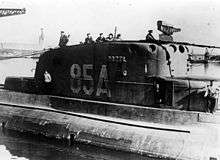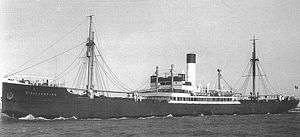ORP Orzeł (1938)
 ORP Orzeł entering the Hel peninsula naval base, 1930s | |
| History | |
|---|---|
| Name: | ORP Orzeł |
| Namesake: | Eagle |
| Builder: | De Schelde, Netherlands |
| Laid down: | 14 August 1936 |
| Launched: | 15 January 1938 |
| Commissioned: | 2 February 1939 |
| Decommissioned: | 11 June 1940 |
| Fate: | missing, presumably sunk |
| General characteristics | |
| Class and type: | Orzeł-class submarine |
| Displacement: |
|
| Length: | 84.00 m (275 ft 7 in) |
| Beam: | 6.7 m (22 ft 0 in) |
| Draught: | 4.17 m (13 ft 8 in) |
| Speed: |
|
| Complement: | 60 |
| Armament: |
|
ORP Orzeł was the lead ship of her class of submarines serving in the Polish Navy during World War II. Her name means "Eagle" in Polish. The boat is best known for the Orzeł incident, her escape from internment in neutral Estonia during the early stages of the Second World War.
History
Orzeł was laid down 14 August 1936 at the Dutch shipyard De Schelde, as the Job No. 205; launched on 15 January 1938, and commissioned on 2 February 1939. She was a modern design (designed by the joint venture of Polish and Dutch engineers), albeit quite large for the shallow waters of the Baltic Sea.
World War II
Polish Campaign
At the beginning of the invasion of Poland Orzeł was docked in Oksywie. As per the Worek Plan, the submarine was deployed on patrol in a designated strategic zone of the Baltic Sea. The crew received specific orders to attack the pre-dreadnought Schleswig-Holstein, should it leave Danzig. With the situation rapidly deteriorating, Orzel abandoned its assigned sector on 4 September, and began to withdraw into the Baltic Sea. The submarine was attacked by the German minesweepers M3 and M4 and damaged, but evaded that evening.
Orzeł incident
Orzel's crew decided to head to Tallinn, Estonia as a result of the damage. Orzeł reached Tallinn on 14 September 1939. On 15 September the captain, Lieutenant-Commander Henryk Kłoczkowski, was forced to leave the submarine to undergo hospital treatment for an unknown illness he had been suffering from since 8 September. Under the Hague Convention of 1907, section XIII, Article 12,[1] "belligerent ships" could enter a neutral port but were forbidden from remaining there for "more than twenty-four hours." At the insistence of Germany, the Estonian military authorities boarded the ship, interned the crew, confiscated all the navigation aids and maps, and commenced removing all her armaments. However, only fifteen of her twenty torpedoes were removed before the hoist cable parted; this was because it had been secretly sabotaged by her new commander, former chief officer, Lieutenant Jan Grudzinski.
The crew of Orzeł conspired together to carry out a daring escape. Around midnight on 18 September, the submarine's Estonian guards were overpowered, the mooring lines were cut, and Orzeł got under way. The alarm was raised, and her conning tower was peppered by machine-gun fire. Running half-submerged, Orzeł ran aground on a bar at the harbour mouth, where artillery fire damaged her wireless equipment. Grudzinski managed to get the boat off the bar by blowing her tanks, and she proceeded out of the Gulf of Finland, intending to sail for a British port, the crew having heard a radio report that the Polish submarine Wilk had been welcomed in Britain.
Orzel escaped from Tallinn with two Estonian guards on board as hostages. The Estonian and German press covering the Orzeł incident declared the two captured guards missing at sea. Grudzinski set them ashore in Sweden, providing them with clothing, money, and food for their safe return to homeland. The Polish crew believed that those returning from the underworld "deserve to travel first class only". The escape of the submarine Orzeł was used by the Soviet Union and Germany to challenge Estonian neutrality.
Scotland



Since Orzeł's navigational charts had all been removed by the Estonian authorities, Captain Grudzinski resolved to stop a German ship and take her charts. However, the only German vessels encountered were warships rather than merchantmen. The submarine's sole remaining navigational aid was a list of lighthouses, and using these as a reference, Orzeł followed a course along the Baltic coast, around Denmark, and out into the North Sea where she came under attack by British as well as German forces, since without her wireless equipment she had no means of identifying herself.
Forty days after she had originally sailed from Gdynia, Orzeł made landfall, off the east coast of Scotland. She lay on the bottom until emergency repairs were made to the radio, then surfaced to transmit a message in English. A Royal Navy destroyer then came out and escorted her into port, much to the surprise of the British who had thought her long since sunk.
Orzeł sank no enemy vessels during her journey from Estonia to Britain, although Soviet authorities blamed her for sinking the Soviet tanker Metallist in Narva Bay on 26 September, the incident being used as a pretext for the Soviet invasion of the Baltic states.[2]
Norwegian Campaign
After a refit, Orzeł was assigned to the Royal Navy's 2nd Submarine Flotilla, and was assigned to patrol missions. Shortly after noon on 8 April 1940 she sank the 5,261 ton clandestine German troop transport Rio de Janeiro off the small harbour village of Lillesand in southern Norway,[3] killing hundreds of German troops intended for the invasion of Norway.[4] Rio de Janeiro was heading to Bergen in order to take part in the initial landings of Operation Weserübung - the invasion of Norway and opening move of the Norwegian Campaign. News that several hundred German soldiers were rescued by the Norwegian Navy and some had admitted their intention to occupy Norway reached the Norwegian parliament that evening, however this news was dismissed and no steps were taken to alert their Navy or Coast Guard of the impending invasion.[5] Two days later Orzeł fired torpedo at a German minesweeper V 705; however, she was forced to dive before the sinking of the German ship could be confirmed-the ship was not damaged by the torpedoes.
Loss
Orzeł departed on her seventh patrol on 23 May, to the central North Sea. On 1 and 2 June a radio message was transmitted from Rosyth ordering her to alter her patrol area and proceed to the Skagerrak. No radio signals had been received from her since she had sailed, and on 5 June she was ordered to return to base. She never acknowledged reception, and never returned to base. 8 June 1940 was officially accepted as the day of her loss. Although various theories exist regarding her loss, and it is commonly believed that she ran onto a mine in the Skagerrak, the true cause of her loss remains unknown to this day. There is the possibility that Orzeł may have been sunk either by a British minefield or by an adjacent German minefield.
Search for the wreck
In July and August 2008 a Polish expedition searched the region of North Sea where she went missing with the hope of finding her final resting place. Wrecks of various other ships have been located, but Orzeł has not been among them and ultimately the fate of the ship remains a mystery.
In June 2013 Polish Navy, following reports of a wreck of an unknown large submarine found in the North Sea, conducted one more expedition to check whether the ship could be Orzeł. The wreck was surveyed and identified as HMS J6.[6]
See also
| Wikimedia Commons has media related to ORP Orzeł. |
- List of World War II ships
- ORP Jastrząb, another Polish submarine lost during World War II.
- List of shipwrecks in 1940
References
- ↑ The Avalon Project - Laws of War : Rights and Duties of Neutral Powers in Naval War (Hague XIII); October 18, 1907
- ↑ Polmar, Norman; Jurrien Noot (1991). Submarines of the Russian and Soviet navies, 1718-1990. Naval Institute Press. p. 95. ISBN 0-87021-570-1.
- ↑ Losses of the German merchant navy on the Rio de Janeiro (German)
- ↑ Norwegian Defence Force website on the sinking of the Rio de Janeiro (Norwegian)
- ↑ Brown, David (1013). Naval Operations of the Campaign in Norway, April-June 1940. Routledge. p. 13. ISBN 9781135273705.
- ↑ Zalesiński, Łukasz (18 October 2013). "Polacy odkryli brytyjski okręt [The Poles discovered a British ship]". Polska Zbrojna (in Polish). Retrieved 5 February 2014.
External links
- http://crolick.website.pl/orporzel/ (English)
- Association of the "ORZEŁ" submarine search group (Polish), (English) and (German),
- Submarine Orzel, the underground truth at the Internet Movie Database, an 2008 Dutch documentary from filmmaker Wouter van Opdorp
- Uboat.net on the Orzeł
- ORP Orzel, a concept album from Cold Fusion
Coordinates: 54°59′N 1°00′E / 54.983°N 1.000°E